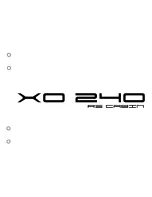
378 Vista™ Owner’s Manual
Section S
Page 10
™
378
The mooring lines you will use most often are the bow
line, the stern line, and spring lines as shown on Fig-
ure S2. Each line has a specific purpose. The bow line
and the stern line secure your boat’s bow and stern.
The two spring lines keep your boat from moving for-
ward or backward when you are moored alongside a
dock.
If you are mooring your boat for a short time, bow and
stern lines may be the only lines you will need. If you
are mooring your boat for a longer time or the currents
are swift, you should use spring lines. The stern spring
line leads from the boat’s stern cleat forward to the
piling or cleat on the dock. The bow spring line leads
from the bow cleat aft to the dock.
If you are mooring your boat in a slip, bow and spring
lines, port and starboard, will keep your boat in posi-
tion.
NOTE:
If tides are a consideration, be sure to leave
slack in the lines to make up for the rise and fall of the
water while your boat is docked.
Figure S2: Mooring Lines
If possible, come in against the wind or current, which-
ever is stronger. Approach the dock at a 30-45° angle.
As the boat nears the dock, slowly swing parallel to it.
Tie the bow line first; then the stern.
If wind or current is moving toward the dock, move
parallel to the dock further out. Let the wind or current
push you in. Tie the stern first, then the bow.
Use extreme caution if wind or current is from your
stern. Back in towards the dock slowly at a slight angle
with engine in slow reverse. Gently swing parallel. Tie
stern first, then the bow.
If the weather looks bad, use spring-lines from the bow
and stern to dock amidships of the boat. Tie up on the
downwind side of the dock. If the wind is changeable,
place fenders over the side between the boat and the
dock.
B. Mooring
After you have positioned your boat next to the dock,
you must secure it with mooring lines to keep it in posi-
tion. Mooring lines must be long enough to secure your
boat in any docking situation. For example, the length
of the lines for a 16-foot runabout should be at least 15
feet. An eye splice at the end of each line works well
with bow or stern cleats.
Содержание 378 VISTA
Страница 1: ...378 VISTA OWNERS MANUAL ...
Страница 51: ...Section C Page 7 378 Vista Owner s Manual 378 Figure C5 Navigational Aids Chart ...
Страница 72: ...Section G Page5 378 Vista Owner s Manual 378 Figure G5 378V Inboard Propulsion System NOT SHOWN ...
Страница 73: ...Section G Page6 378 Vista Owner s Manual 378 Figure G6 Tie Bar 47 1 4 Tiller Arm Assembly ...
Страница 162: ...Service Log Page 1 378 Vista Owner s Manual 378 SERVICE LOG E T A D S R U O H D E M R O F R E P E C N A N E T N I A M ...
Страница 163: ...Service Log Page 2 378 Vista Owner s Manual 378 SERVICE LOG E T A D S R U O H D E M R O F R E P E C N A N E T N I A M ...
Страница 164: ...Service Log Page 3 378 Vista Owner s Manual 378 SERVICE LOG E T A D S R U O H D E M R O F R E P E C N A N E T N I A M ...
Страница 166: ...Locator Drawing Page 1 378 378 VISTA LOCATOR DRAWING 378 Vista Owner s Manual ...
Страница 196: ... Page 30 CLARION AMPLIFIER APX400 4M CONNECTIONS SETTINGS Electrical Schematics ...
Страница 199: ......
Страница 200: ......
Страница 201: ...A G E N M A R C O M P A N Y P A R T 0 9 0 2 7 4 4 ...
















































